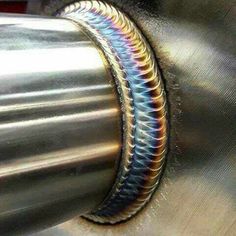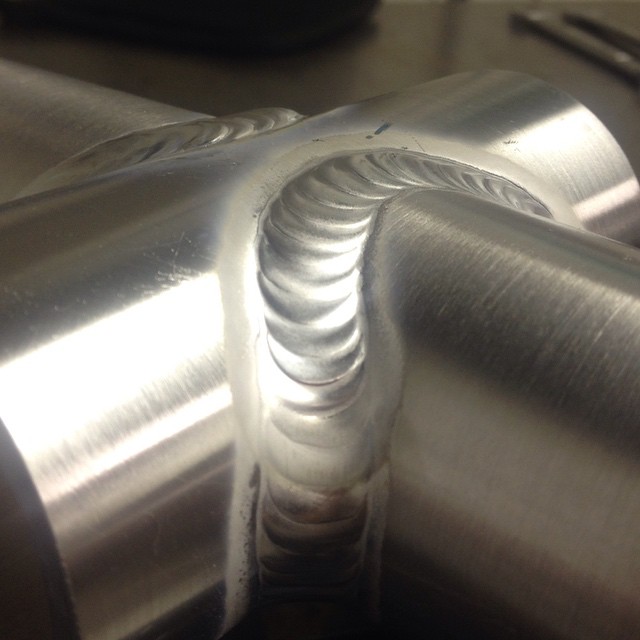The process of pulse TIG welding is used to join different metals. Pulsing current is used in this particular variety of TIG welding. This makes the weld more stable and improves the weld’s quality.
However, due to the fact that it generates less heat than other welding techniques, pulse TIG welding is frequently used to join thin materials, such as aluminum.
I’ve also covered what pulse welding is and how it differs from tig welding. Therefore, if you are aware of it, the article below will be useful to you.
What Is Pulse TIG Welding and How Does it Work?
A pulsating current is used during the welding process known as pulse welding to create welds. The metal is melted by the pulsating current, which also forms a weld. Diverse metals can be joined together using pulse welding.
What is The Purpose of Pulse Tig Welding?
Metals were welded together using pulse TIG welding. A pulsing current is used in the process, which employs a TIG welder to do the welding.
Because it produces a weld that is incredibly robust, this method of welding is frequently employed to join aluminum. Steel and stainless steel can be welded using pulse TIG technology.
Automotive maintenance and sheet metal fabrication both frequently use pulse tig welding.
When Should Use Pulse TIG Welding?
When putting two different kinds of metal together, pulse might be utilized. The welds become more durable and reliable as a result. When using pulse welding, a very high voltage and a strong electrical current are used to cut the wire.
The metal can be joined together by welding because of how quickly the wire warms up. Short circuit welding is another name for pulse welding.
Any length and size of the wire can be achieved. The pulse’s energy and speed can be changed. It is quick, dependable, and simple to utilize pulse welding. Any weld size is possible as long as it fits inside the torch. Although it consistently gives good results, mastering it takes practice.
The Function of Pulse Welding
The simplest way to make TIG welds is to use a pulse throughout the welding process. The metal being joined is attached to a tungsten electrode, and current is then delivered out to the wire.
As the current flows through the tungsten, a ball of blazing plasma is created. The plasma is transported to the joint by a stream of inert gas. The metal layers are fused there.
A conventional TIG welding process is used to create an inert gas stream. The same welding torch is used for this, but with a different kind of tip. An inverter is used to transmit the pulse to the tungsten electrode.
The voltage applied to the arc is also managed by the inverter. In this instance, the voltage typically ranges from 200 V to 600 V. The amount of heat produced increases with voltage. This strengthens the weld.
How Do I Use The Pulse Settings?
Depending on the material you’re using and the object you’re trying to weld, there are various pulse settings.
Generally speaking, you should use the lowest setting. This will result in the weld bead with the shortest diameter. A bigger weld bead will result from using higher pulse rates, such as the 40% setting.
For thinner metal thicknesses, such as 1/16-inch thick, you can use the 70–80% setting, whereas thicker materials work well with a lower 40–60% setting.
The 100% setting can be used for any kind of material and produces a bigger weld bead. Use the 80-100% setting for joining carbon steel and stainless steel in a welding process.
A nice weld will result from this. For carbon steel, use the 80% setting, while for stainless steel, use the 100% setting.
How Should I Set My Pulse?
If you need some assistance, you can try the pulse settings we’ve listed below. But bear in mind that they greatly differ depending on the application! Therefore, avoid trying pulse welding on a critical component that you cannot replace because you will initially make mistakes.
Pulse TIG Welding Mild Steel
A pulse should not be used while welding light steel. Increased oxidation and brittle welds may result from it. The welds will therefore be more susceptible to breaking and rusting.
However, if you are determined to explore, I advise beginning with a 1Hz frequency and a heat difference between the maximum and lower limits of power output of no more than 30%. Please don’t pulse weld anything that could endanger you or others unless you are a professional and the weld will go through a rigorous inspection process. This includes structural steel.
Pulse TIG Welding Stainless Steel

The process of welding stainless steel is very different. The stainless steel weld production quality and welding efficiency are both greatly increased by the pulse welding process.
As it becomes hot, stainless steel quickly loses its ability to resist corrosion. Carbon is concentrated by excess heat in the heat-affected zone and becomes trapped as the metal cools. Since stainless steel is frequently used in situations where corrosion resistance is crucial, this is counterproductive.
Pulsed TIG welds are therefore essential for creating flawless stainless steel connections. The quality of the weld increases with frequency. A stronger weld results from the higher puddle agitation due to the improved molecular grain structure.
But most crucially, a high-speed pulse narrows the heat-affected zone, deepens penetration, and constricts the arc. I advise experimenting with frequencies between 30 and 500 pulses per second. You should locate a sweet spot in the middle depending on the thickness and the desired outcome.
I wouldn’t limit the current below 50% of the peak current level, considering the gap between peak amperage and background current.
Pulse Welding Aluminum

Pulsing aluminum with a TIG is difficult. Because it loses heat quickly, this metal needs a lot of heat input. Thus, welding thin gauges is the sole application where reducing the heat input with background amperage is advantageous. If you don’t, you might not be able to penetrate deeply enough.
When welding aluminum corner joints, pulse welding is extremely helpful.
Additionally, the pulse setting of roughly 1.5–2 Hz frequency can stack up neatly and doesn’t require any clean-up if you don’t use filler wire.
Higher pulses per second numbers cause your welding pace to slow down, which is advantageous for some applications. Because the base metal behind the oxide layer melts at a lower temperature than oxide, welding aluminum requires a quick travel speed to prevent burn-through.
Benefits of the Pulse TIG Welder
The benefits of pulse welding over traditional arc welding are numerous. The user can regulate the welding time and temperature. A significant amount of metal can melt due to the heat’s extreme intensity. Additionally, you may decide how much heat you want and the appropriate voltage to use to generate it.
Its numerous benefits have increased its popularity more than before. It can be used for a variety of things, including joining stainless and carbon steel.
The Challenge of Pulsed TIG Welding
TIG pulse welding is notoriously challenging. To guide a pulsing flame along the joint, particularly while adding a filler wire, requires a deft hand and a skilled welder.
Pulse welding is not suitable for novices. Prior to attempting to pulse TIG weld, you should first perfect the regular TIG welding process. However, you can use your TIG foot pedal to “pulse” at a 1Hz frequency by pressing and releasing it at a rate of one cycle per second to simulate pulse welding. That is a fantastic method to begin pulse welding without purchasing a welder with pulse capability.
If you try to employ a real pulse welding process and fail, don’t give up. Even experienced TIG welders take considerable practice to perfect the use of pulsed arc.
Tuning the pulsed parameters and incorporating the arc into your welding processes present another hurdle.
Compared to a fundamental 1Hz pulse, a high-speed pulse acts quite differently. Therefore, it requires fiddling with the machine and figuring out the proper parameters in order to create a perfect stack of beads and boost production by pulsing arc.
FAQs
Conclusion
Overall, pulse tig welding is a productive, adaptable welding process that is utilized for a wide range of applications. In comparison to other welding techniques, it has various benefits such as high-quality welds, low heat input, and less distortion.
The popularity of pulse tig welding among welders is rising as a result of its many advantages.

With 8 years of experience a senior welding instructor and safety equipment researcher and writes articles, reviews and guidelines on helmets and other welding and safety gears at Welder Choice, and other written works have been published in various publications.
